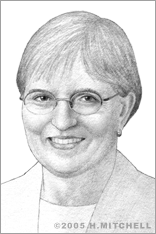Elsa Reichmanis
Polymer chemist Elsa Reichmanis was born on December 9, 1953 in Melbourne, Australia. As a child she emigrated with her family to the United States and grew up in Syracuse, New York. An impressive student, she graduated from high school early and enrolled at Syracuse University as a chemistry major. She excelled in her studies and completed her bachelor’s degree in three years, graduating in 1972. Just three years later, she also completed a doctoral degree at Syracuse and received a PhD in organic chemistry in 1975 at the age of 22.
Reichmanis spent three years working as a postdoctoral fellow and wrestled with the decision between an academic career and one in the commercial world. She chose the commercial path, accepting a staff position with AT&T Bell Laboratories, currently known as Bell Labs.
It was not long before Reichmanis began to make her mark with the company, and quickly she found herself at the forefront of her field, working to design materials suitable for use in the communications network infrastructure of the future. In the 1980s, she and her research group took on the task of developing advanced materials meant for the burgeoning semiconductor industry. Reichmanis worked on new materials for nanoscale fabrication of the layers of lines and channels on silicon chips made using optical lithography.
In the field of semiconductor manufacturing, the process of defining or outlining patterns on silicon wafers so that materials can be applied to or removed from them according to these “maps” to make the chip work is called lithography. Optical lithography uses visible or ultraviolet light to project patterns on the wafer. In order for this to work, the wafer is coated with a chemical substance known as a “photoresist,” which captures the desired pattern similar to the way photographic paper captures an image.
Photoresists have been a focus of Reichmanis’ work. She and her team developed advanced materials of this type for faster, more powerful chips with smaller and smaller components; today’s semiconductors can have more than 40 million transistors each. Groundbreaking materials she and her team developed known as “chemically amplified resists” are currently used in silicon fabrication facilities around the world. Her team was among the first to come up with materials that would be suitable for the rapidly advancing world of chips that were necessary for the new millennium.
Reichmanis continued to make major contributions to her field over the course of her career with Bell Labs. She served for six years on the Technical Staff with the company’s Organic Chemistry Research and Development department, followed by a post as Technical Manager, Radiation Sensitive Materials and Applications, which she held for ten years until 1994. That year she was promoted to Director, Polymer and Organic Materials Research.
She worked on a variety of projects including, the design and application of photonic polymer technologies for optical networks. Some of her past accomplishments included working with E Ink Corp. to create the world’s first, reusable, all-plastic "electronic paper." And with DuPont and Sarnoff Corp. she helped develop a material for light, portable, flexible color display screens.
Reichmanis has several patents, five books, and more than 150 publications to her credit. Her long list of honors and awards include the 1992 R&D 100 Award from Research and Development Magazine; the 1993 Achievement Award from the Society of Women Engineers; the 1996 ASM International Engineering Materials Achievement Award; and the 2001 Perkin Medal. In addition, she was elected to the National Academy of Engineering in 1995; she became an AT&T Bell Laboratories Fellow, also in 1995; and she was named a Fellow of the American Association for the Advancement of Science in 1997. In 2003, Reichmanis served as the president of the American Chemical Society (ACS).
Reichmanis is currently Brook Byers Professor in the School of Chemical and Biomolecular Engineering at Georgia Institute of Technology.


